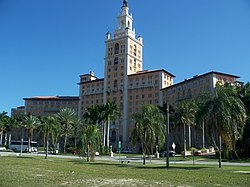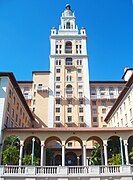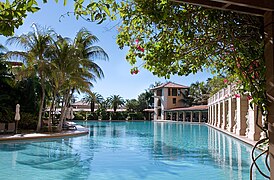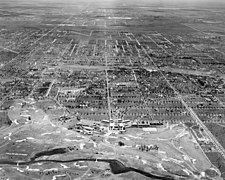Miami Biltmore Hotel
hideThis article has multiple issues. Please help or discuss these issues on the talk page. (Learn how and when to remove these template messages)
|
Miami-Biltmore Hotel & Country Club | |
U.S. National Register of Historic Places | |
 The Biltmore in March, 2011 | |
 | |
| Location | Coral Gables, Florida |
|---|---|
| Coordinates | 25°44′28″N 80°16′45″W / 25.74111°N 80.27917°WCoordinates: 25°44′28″N 80°16′45″W / 25.74111°N 80.27917°W |
| Built | 1926 |
| Architect | Schultze and Weaver[1] |
| Architectural style | Mission/Spanish Revival/Italian Renaissance[1] |
| NRHP reference No. | 72000306[1] |
| Significant dates | |
| Added to NRHP | September 27, 1972[1] |
| Designated NHL | June 19, 1996[2] |
The Miami Biltmore Hotel is a luxury hotel in Coral Gables, Florida, United States. It was designed by Schultze and Weaver and was built in 1926 by John McEntee Bowman and George Merrick as part of the Biltmore hotel chain. The tower is inspired by the Giralda, the medieval tower of the cathedral of Seville. When completed it became the tallest building in Florida at 315 feet (96 m)[3] holding the record until 1928 when the Dade County Courthouse was built. At one time, the pool was the largest pool in the world and employed swimming instructor (and later Tarzan actor) Johnny Weissmuller.[4] It served as a hospital during World War II and as a VA Hospital and campus of the University of Miami medical school until 1968. Abandoned for many years it became a hotel again in 1987.
It was designated a National Historic Landmark in 1996.[2]
History[]
In 1925, land developer George E. Merrick joined forces with Bowman-Biltmore Hotels president John McEntee Bowman at the height of the Florida land boom to build "a great hotel...which would not only serve as a hostelry to the crowds which were thronging to Coral Gables but also would serve as a center of sports and fashion." In January 1926, after ten months of construction at a cost of $10 million, the hotel debuted with an inaugural that brought people down from northern cities on trains marked "Miami Biltmore Specials."[citation needed]
Visitors included the Duke and Duchess of Windsor, Ginger Rogers, Judy Garland, Bing Crosby, Al Capone, and assorted Roosevelts and Vanderbilts as frequent guests. Franklin D. Roosevelt had a temporary White House office set up at the Hotel when he vacationed in Miami. There were many gala balls and aquatic shows by the grand pool, with the grounds acting as a venue for weddings and golf tournaments.[citation needed]
Just months after the hotel opened, on September 18, the 1926 Miami Hurricane struck. While the hotel was undamaged, providing shelter for over 2000 survivors, the disaster signaled the end of the Florida land boom.[5]
Merrick's Coral Gables company declared bankruptcy on April 13, 1929, and Merrick's stake in the hotel was bought out by his partner, John McEntee Bowman in November 1929 for $2.1 million.[5] Bowman resold the hotel in September 1931 to millionaire Henry Latham Doherty. A large part of the hotel's revenue in the 1930s came from aquatic galas.[citation needed] As many as 3,000 would come out on a Sunday afternoon to watch the synchronized swimmers, bathing beauties, and alligator wrestling. Johnny Weissmuller, before he was known for his role in Tarzan, broke a world record at the pool.[citation needed]
With the onset of World War II, the War Department took over the hotel, converting it to a 1200-bed hospital in November 1942. The building was transferred to the Army in 1946 and renamed Pratt General Hospital.[6] Many of the windows were sealed with concrete, and the marble floors covered with government-issue linoleum. The hospital was transferred from the Army to the Veterans Administration (VA) in July 1947.[5] Also the early site of The University of Miami's School of Medicine, Pratt General Hospital remained a VA hospital, with 450 beds, until a newer facility opened nearby in May 1968 and the building was vacated.[6]
In 1973, through the Historic Monuments Act and Legacy of Parks program, the City of Coral Gables was granted ownership control. The building remained unoccupied for almost 10 years. Then in 1983, the City oversaw its full restoration to be opened as a grand hotel. It was reopened on December 31, 1987 as a luxury hotel and resort.[citation needed]
In June 1992, a multinational consortium led by Seaway Hotels Corporation became the new operators of the hotel under a long term management lease with the City of Coral Gables, and again made extensive refurbishments to the property. New lighting and telephone systems, repairs to the pool, furnishings, a complete guestroom renovation program and spa were completed.[citation needed]
In February 2009, the hotel opened a Culinary Academy. The Biltmore Culinary Academy is a recreational hands-on cooking school with classes for adults and children taught by the hotel's chefs.[7]
On April 18, 2012, the AIA's Florida Chapter placed the building on its list of Florida Architecture, 100 Years, 100 Places.[8][9] The hotel is on a list of supposedly haunted locations. Mobster Thomas Walsh was killed while staying at the hotel in 1929.[10][11]
The hotel has been used as a setting in various movies and television programs such as Bad Boys, The Specialist, Shock Waves, CSI: Miami, Popi, and Miami Vice.
Golf[]
The hotel has an 18-hole, par 71, championship course designed by Donald Ross. Reopened in November 2007, following a $5 million investment, the course was restored and updated by Brian Silva.[12] The original 1925 routing was retained, but all greens, tees, and bunkers were reconstructed and grassed to contemporary standards. The property again contracted Silva to provide additional improvements to the golf course in the summer of 2018.
Spa[]
The hotel has a 12,000-square-foot (1,100 m2) full service spa which is a member of the Leading Spas of the World.
Gallery[]

Front of hotel

Rear view

Pool

Pool

Golf course

Arcade and courtyard with fountain

One of the reception halls

Fountain

Biltmore Hotel at Coral Gables from the air
References[]
- ^ Jump up to: a b c d "National Register Information System". National Register of Historic Places. National Park Service. July 9, 2010.
- ^ Jump up to: a b "Miami-Biltmore Hotel & Country Club". National Historic Landmark summary listing. National Park Service. Archived from the original on 2009-04-25. Retrieved 2009-07-03.
- ^ "The Biltmore Hotel, Coral Gables | 123896". Emporis. Retrieved 2016-06-28.
- ^ Greg Jenkins Florida's Ghostly Legends and Haunted Folklore: South and central Florida, Volume 1 page 22
- ^ Jump up to: a b c https://npgallery.nps.gov/NRHP/GetAsset/NHLS/72000306_text
- ^ Jump up to: a b "Our History - Miami VA Healthcare System". Miami.va.gov. Retrieved 2016-06-28.
- ^ "Get Your Dough On: Biltmore Miami Cooking Classes - TravelMuse". 2009-02-20.
- ^ "Start Voting for Your Favorite Florida Architecture!". 2018 People's Choice Award (Florida Architecture). Retrieved 12 January 2019.
- ^ "Florida Architecture: 100 Years. 100 Places".
- ^ "Coral Gables Biltmore Hotel". Archived from the original on 2010-08-16. Retrieved 2010-07-20.
- ^ Deena Budd. "Haunted Biltmore Hotel in Coral Gables". Retrieved 2010-07-20.
- ^ "Renovation at Miami's Biltmore Golf Course brings Donald Ross design back to life". 2019-01-18.
External links[]
| Wikimedia Commons has media related to Biltmore Hotel at Coral Gables. |
- Hotels in Florida
- Bowman-Biltmore Hotels
- Buildings and structures in Coral Gables, Florida
- National Register of Historic Places in Miami-Dade County, Florida
- Tourist attractions in Miami-Dade County, Florida
- National Historic Landmarks in Florida
- Hotels established in 1926
- Hotel buildings completed in 1926
- Reportedly haunted locations in Florida
- 1926 establishments in Florida
- Hotels in Miami-Dade County, Florida













